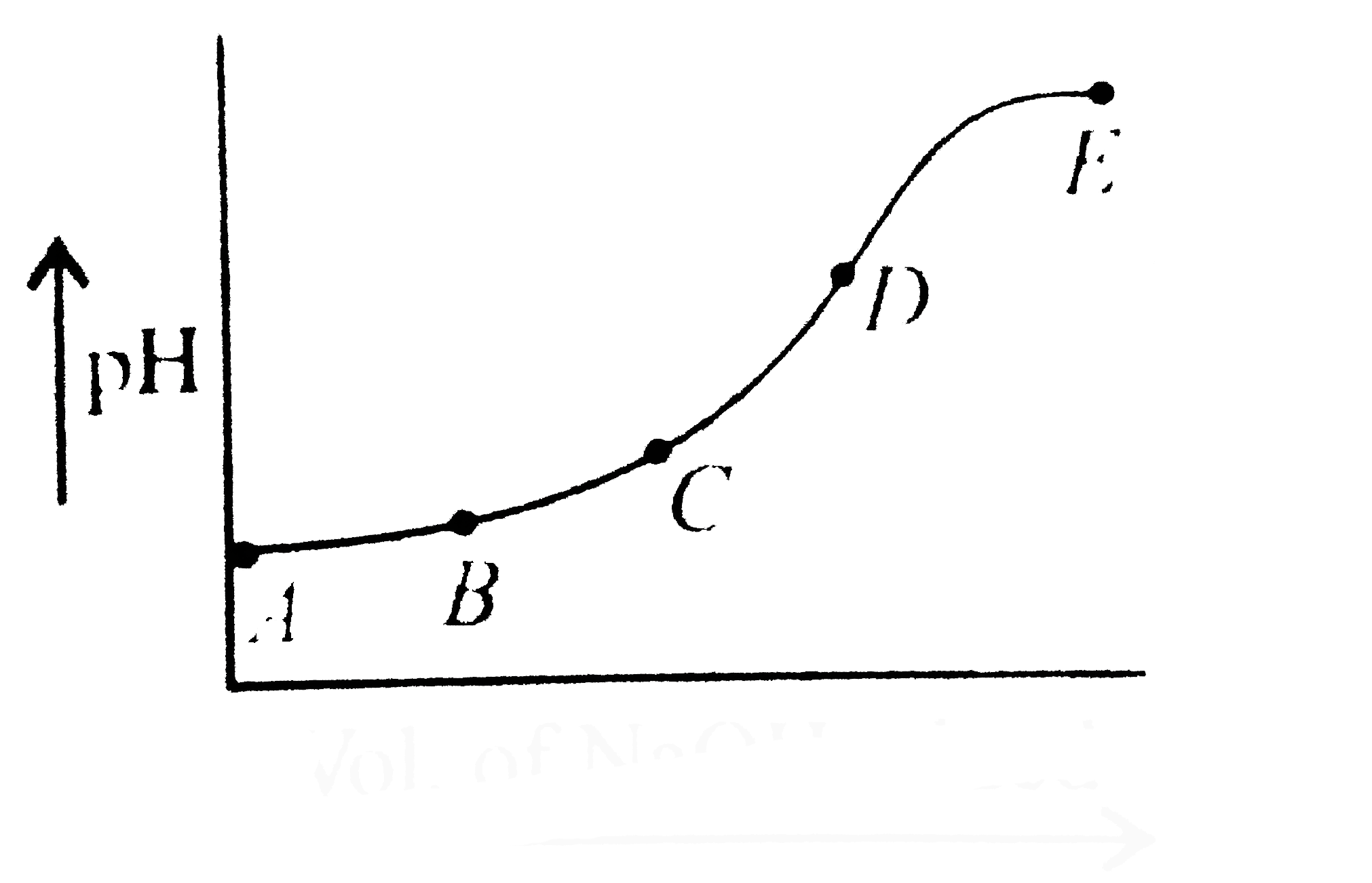The rapid change of pH near the stoichiometric point of an acid-base titration is the basis of indicator detection. pH of the solution is related to ratio of the concentration of the conjugate acid (Hin) and base [H+]=10−7+10−8=10−7[1+0.1] forms of the indicator by the expression
log.[HIn][In−]=pH−pKIn
log.[In−][HIn]=pH−pKIn
log.[In−][HIn]=pKIn−pH
log.[HIn][In−]=pKIn−pH
The correct Answer is:B
To solve the problem regarding the relationship between pH and the ratio of concentrations of the conjugate acid (HIn) and base (In⁻) forms of an indicator during an acid-base titration, we can follow these steps:
1. Understanding the pH Relationship:
The pH of the solution can be related to the concentrations of the conjugate acid (HIn) and the conjugate base (In⁻) using the Henderson-Hasselbalch equation:
pH=pKa+log((In−)(HIn))
2. Identify the Components:
- Here, (In−) is the concentration of the base form of the indicator.
- (HIn) is the concentration of the acid form of the indicator.
- pKa is the negative logarithm of the acid dissociation constant for the indicator.
3. Substituting Known Values:
- In the problem, we are given that (H+)=10−7+10−8=1.1×10−7.
- This implies that the pH can be calculated as:
pH=−log(1.1×10−7)
4. Calculating pH:
- To find the pH, first calculate:
pH≈7+log(1.1)≈7+0.041=7.041
5. Rearranging the Henderson-Hasselbalch Equation:
- Rearranging the equation gives us:
log((In−)(HIn))=pH−pKa
6. Final Expression:
- Thus, we can express the relationship as:
(In−)(HIn)=10(pH−pKa)
Conclusion
The final expression relates the pH of the solution to the ratio of the concentrations of the conjugate base and acid forms of the indicator, which is crucial for understanding how indicators function in acid-base titrations.
The pH of the solution can be related to the concentrations of the conjugate acid (HIn) and the conjugate base (In⁻) using the Henderson-Hasselbalch equation:
pH=pKa+log((In−)(HIn))
- Here, (In−) is the concentration of the base form of the indicator.
- (HIn) is the concentration of the acid form of the indicator.
- pKa is the negative logarithm of the acid dissociation constant for the indicator.
- In the problem, we are given that (H+)=10−7+10−8=1.1×10−7.
- This implies that the pH can be calculated as:
pH=−log(1.1×10−7)
- To find the pH, first calculate:
pH≈7+log(1.1)≈7+0.041=7.041
- Rearranging the equation gives us:
log((In−)(HIn))=pH−pKa
- Thus, we can express the relationship as:
(In−)(HIn)=10(pH−pKa)
The final expression relates the pH of the solution to the ratio of the concentrations of the conjugate base and acid forms of the indicator, which is crucial for understanding how indicators function in acid-base titrations.
Topper's Solved these Questions
- IONIC EQUILIBRIUMBOOK - ERRORLESS CHAPTER - IONIC EQUILIBRIUMEXERCISE - Critical thinking (Objective question )
78 Videos
- IONIC EQUILIBRIUMBOOK - ERRORLESS CHAPTER - IONIC EQUILIBRIUMEXERCISE - JS Jee Section (Only one choice correct answer)
48 Videos
- IONIC EQUILIBRIUMBOOK - ERRORLESS CHAPTER - IONIC EQUILIBRIUMEXERCISE - Ordinary Thinking (Common ion effect, Isohydric solutions, Solubility product, Ionic product of water and Salt hydrolysis )
137 Videos
- HYDROCARBONBOOK - ERRORLESS CHAPTER - HYDROCARBONEXERCISE - JEE SECTION (Matrix Match type questions)
6 Videos
- NITROGEN CONTAINING COMPOUNDS BOOK - ERRORLESS CHAPTER - NITROGEN CONTAINING COMPOUNDS EXERCISE - JEE (ADVANCED) 2018 MORE THAN ONE CHOICE CORRECT ANSWER
1 Videos
Similar Questions
What is the pH of 7.0×10−8M acetic acid. What is the concentration of un-ionsed acetic acid. Ka of CH3COOH=1.8×10−5.
View SolutionThe rapid change of pH near the stoichiometric point of an acid-base titration is the basic of indicator detection. pH of the solution is related to the ratio of the concentration of conjugate acid (H∈) and base (In−) forms of the indicator by the expression
View Solution
Knowledge Check
The rapid change of pH near the stoichiometric point of an acid base titration is the basis of indicator detectio. pH of the solution is related to ratio of the concentrations of the conjugate acid (Hin) and base (In−) forms of the indicator given by the expression
Alog[In−][HIn]=pKIn−pHBlog[HIn][In]=pKIn−pHClog[HIn][In−]=pH−pKInDlog[In−][HIn]=pH−pKInThe rapid change of pH near the stoichiometric point of an acid-base titration is the basic of indicator detection. pH of the solution is related to the ratio of the concentration of conjugate acid (H∈) and base (In−) forms of the indicator by the expression
Alog[[In−][HIn]]=pKa+pHBlog[[HIn][In−]]=Ka+pHClog[[In−][HIn]]=pH+pKaDlog[[In−][HIn]]=pH−pKaThe rapid change of pH near the stoichiometric point of an acid base titration is the basis of indicator detectio. pH of the solution is related to ratio of the concentrations of the conjugate acid (Hin) and base (In−) forms of the indicator given by the expression
Alog([In−])[Hun]=pKIn−pHBlog([HIn])[In−]=pKIn−pHClog([HIn])[In−]=pH−pKInDlog([In−])[HIn]=pH−pKIn
The rapid change of pH near the stocichiometric point of an acid-base titration is the basis of indicator detrection. pH of the solution is related to the ratio of concentration of conjugate acid (HIn) to the concentration of base (In−) froms of the indicator by the expression
View SolutionAssertion. The pH at the end point of any acid-base titration is always 7.
Reason. The aqueous solution of a salt is always neutral.
View SolutionThe following curve shows the change of pH during the course of titration of weak acid HA with a strong base. At which point in the titration curve is the concentration of acid equal to that of its conjugate base.

View SolutionThe best indicator for detection of end point in titration of a weak acid and a strong base is
NB Figures in the brackets show the pH range of the indicator .
View SolutionIn a solution of acid H+ concentration is 10−10M. The pH of this solution will be
View Solution
